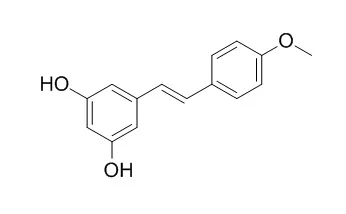| Description: |
Desoxyrhapontigenin has significant hypoglycemic, anti-inflammatory, and antioxidant effects, it shows inhibition of iNOS and COX-2 expression via the down-regulation of the MAPK signaling pathways and the inhibition of NF-κB and Akt activation.
Desoxyrhapontigenin up-regulates Nrf2-mediated heme oxygenase-1(HO-1) expression in macrophages and inflammatory lung injury, and HO-1 is an important anti-inflammatory, antioxidative and cytoprotective enzyme. Desoxyrhapontigenin shows significant monoamine oxidase inhibitory activities with the IC50 value of 11.5 ± 1.1 uM. |
| Targets: |
Nrf2 | HO-1 | NOS | COX | NF-kB | Akt | MAPK | JNK | SOD | ERK |
| In vitro: |
| Redox Biol. 2014 Feb 18;2:504-12. | | Desoxyrhapontigenin up-regulates Nrf2-mediated heme oxygenase-1 expression in macrophages and inflammatory lung injury.[Pubmed: 24624340 ] | Heme oxygenase-1 (HO-1) is an important anti-inflammatory, antioxidative and cytoprotective enzyme that is regulated by the activation of the major transcription factor, nuclear factor (erythroid-derived 2)-like 2 (Nrf2).
METHODS AND RESULTS:
In the present study, six stilbene derivatives isolated from Rheum undulatum L. were assessed for their antioxidative potential. In the tert-butylhydroperoxide (t-BHP)-induced RAW 264.7 macrophage cell line, Desoxyrhapontigenin was the most potent component that reduced intracellular reactive oxygen species (ROS) and peroxynitrite. In response to Desoxyrhapontigenin, the mRNA expression levels of antioxidant enzymes were up-regulated. An electrophoretic mobility shift assay (EMSA) confirmed that Desoxyrhapontigenin promoted the DNA binding of Nrf2 and increased the expression of antioxidant proteins and enzymes regulated by Nrf2. Further investigation utilizing specific inhibitors of Akt, p38, JNK and ERK demonstrated that the phosphatidylinositol 3-kinase (PI3K)/Akt pathway mediates HO-1 expression. Moreover, the increase in Nrf2 expression mediated by treatment with Desoxyrhapontigenin was reversed by Nrf2 or Akt gene knock-down. In the LPS-induced in vivo lung inflammation model, pretreatment with Desoxyrhapontigenin markedly ameliorated LPS-induced lung inflammation and histological changes. Immunohistochemical analysis of Nrf2, HO-1 and p65 was conducted and confirmed that treatment with Desoxyrhapontigenin induced Nrf2 and HO-1 expression but reduced p65 expression.
CONCLUSIONS:
These findings suggest that Desoxyrhapontigenin may be a potential therapeutic candidate as an antioxidant or an anti-inflammatory agent. | | Nat Prod Res. 2013;27(10):946-9. | | Activity-guided isolation of antioxidants from the roots of Rheum emodi.[Pubmed: 22568567] | | An activity-guided isolation and purification process was used to identify the DPPH free radical scavenging components of Rheum emodi. The activity-guided isolation revealed that eugenol, gallic acid, quercetin, rutin, epicatechin, Desoxyrhapontigenin, rhapontigenin and mesopsin are the major phenolic compounds responsible for the antioxidant activity of the roots of R. emodi. |
|
| In vivo: |
| Pharm Biol. 2010 Jun;48(6):703-7. | | Hypoglycemic and antioxidant effects of Rheum franzenbachii extract in streptozotocin-induced diabetic rats.[Pubmed: 20645745 ] | The hypoglycemic and antioxidant effects of ethanol extract from the roots and rhizomes of Rheum franzenbachii Münt. (Polygonaceae) were evaluated in streptozotocin-induced diabetic rats.
METHODS AND RESULTS:
Effects of repeated oral administration of ethanol extract (125, 250, and 500 mg/kg body weight) on the plasma glucose level (PGL), oral glucose tolerance test (OGTT), malondialdehyde (MDA), reduced glutathione (GSH), superoxide dismutase (SOD), and catalase (CAT) in diabetic rats were examined. It was found that administration of ethanol extract (125, 250, and 500 mg/kg) produced a significant fall in PGL, AUC, and MDA, while elevating the GSH levels and SOD and CAT activities in diabetic rats. The dose of 500 mg/kg was identified as the most effective dose, with a decrease of 65.8 and 44.0% in PGL and MDA, and elevation of 72.6, 75.0, and 51.5% in GSH level and SOD and CAT activities, respectively, after 14 days of ERF administration in diabetic rats. Moreover, the OGTT studies showed a maximum reduction in PGL and AUC. From the active extract of Rheum franzenbachii, two stilbenes, Desoxyrhapontigenin (1) and desoxyrhaponticin (2), were isolated as major constituents.
CONCLUSIONS:
The present study concludes that the ethanol extract of roots and rhizomes from Rheum franzenbachii had significant hypoglycemic and antioxidant effects. |
|






 Cell. 2018 Jan 11;172(1-2):249-261.e12. doi: 10.1016/j.cell.2017.12.019.IF=36.216(2019)
Cell. 2018 Jan 11;172(1-2):249-261.e12. doi: 10.1016/j.cell.2017.12.019.IF=36.216(2019) Cell Metab. 2020 Mar 3;31(3):534-548.e5. doi: 10.1016/j.cmet.2020.01.002.IF=22.415(2019)
Cell Metab. 2020 Mar 3;31(3):534-548.e5. doi: 10.1016/j.cmet.2020.01.002.IF=22.415(2019) Mol Cell. 2017 Nov 16;68(4):673-685.e6. doi: 10.1016/j.molcel.2017.10.022.IF=14.548(2019)
Mol Cell. 2017 Nov 16;68(4):673-685.e6. doi: 10.1016/j.molcel.2017.10.022.IF=14.548(2019)